thank you for sharing this. i read this this morning, was having a friend over today and made it. i used frozen bananas instead of ice cubes. it was divine!

Ever feel like you're caught in a breakfast rut or need that midday pick-me-up that's both delish and nutritious? Well, have you met the Matcha Smoothie yet? Think of it as the morning buddy you never knew you needed, or the afternoon friend who shows up at just the right time. Yup, this quick and creamy blend has your back!
You've probably heard the buzz around matcha, right? That green wonder from Japan that’s taken the world by storm. While we know it makes a killer latte, did you know it can elevate your smoothie game, too? It's like adding a superpower boost to your day, without the fancy equipment or hard-to-find ingredients.
Why is this such a big deal? Think about it: Matcha is not just green tea; it's like green tea on overdrive. You're getting more antioxidants, more flavor, and that nice, slow caffeine kick without the jitters. And when it hangs out with everyday heroes like bananas and milk, you’ve got yourself a little liquid Zen garden right in your blender. Plus, if you’ve never mixed matcha with banana, you’re in for a whole new world of yum.
So, no more boring breakfasts or lackluster lunches. This Matcha Smoothie is a celebration of simplicity and flavor, and it's calling your name. In just six easy steps, you’re not just making a smoothie, you're creating your own sip-able masterpiece. Ready to blend up some magic?
JUMP TO:
INGREDIENTS:
Quality is paramount when it comes to Matcha: When selecting your Matcha tea powder, opt for ceremonial-grade over culinary-grade. Ceremonial-grade offers a smoother, richer flavor and contains more antioxidants. Pay attention to the color as well; the brighter the green, the fresher and higher the quality of the Matcha. Some chefs also recommend testing the powder by rubbing a small amount between your fingers; a smooth, fine texture is indicative of higher quality.
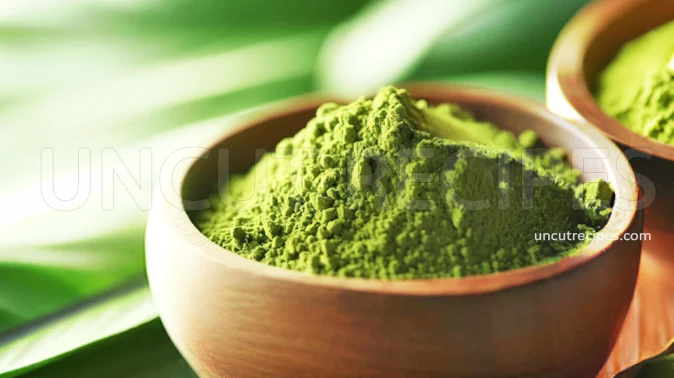
Why This Ingredient is Used: Matcha brings the unique, earthy, and slightly sweet flavors that are the cornerstone of this smoothie. It also contributes antioxidants, lending health benefits in addition to taste.
Alternatives: If Matcha is too strong for your palate, consider using Sencha powder for a milder, but still authentically Japanese, flavor. You can also use Spirulina for a similar green color but a different flavor profile.
Milk Considerations: If you're making this for a specialized crowd that has lactose intolerance or is vegan, opt for plant-based milks. Almond, oat, or cashew milk work well as substitutes, each offering a slightly different nuance to the flavor.
Why This Ingredient is Used: Milk serves as the liquid base of the smoothie, providing a creamy texture that complements the strong Matcha flavor.
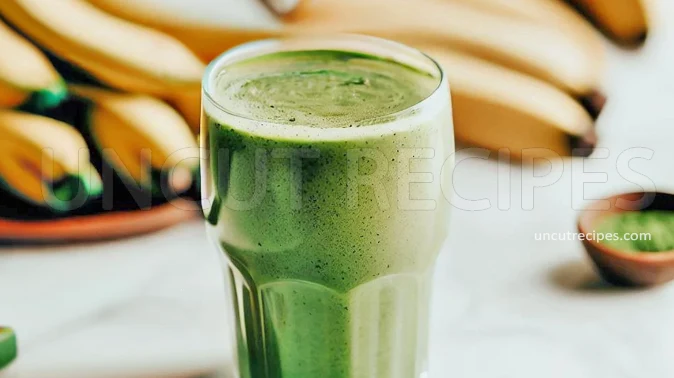
Alternatives: Coconut milk can offer a tropical twist, while kefir or yogurt can add tanginess and additional creaminess to the smoothie.
Evaluating Bananas: Choose a ripe but not overripe banana. Look for a banana with a yellow peel and minimal black spots. A slightly green stem can be a good indicator that the banana is at its peak ripeness.
Why This Ingredient is Used: Bananas provide natural sweetness and creaminess, reducing the need for additional sugar or artificial thickeners.
Alternatives: If you're looking to lower the sugar content, avocados can offer creaminess without the sweetness. If you're looking for an alternative sweetener, a spoonful of honey or a dash of Stevia could work.
MAIN STEPS:
Before adding your liquid and Matcha, give your ice and banana a quick initial blend. This ensures that you won't have any chunky surprises in your otherwise smooth concoction. Don't overdo it; just break them down into smaller, more manageable pieces.
The Final Blend: After adding your milk and Matcha, give everything a final blend until smooth. It's crucial not to overblend, as Matcha can lose some of its delicate flavors with too much heat from the blender. Aim for a texture that's creamy but not frothy.
SERVED WITH:
Starter: Avocado Toast (USA): A simple yet delicious dish featuring toasted bread slices topped with mashed avocados, salt, and sometimes additional toppings like tomatoes or feta cheese.
Side Dish: Edamame (Japan): Boiled young soybeans in the pod, usually served with salt. A great, protein-rich complement to the antioxidant qualities of a Matcha Smoothie.
Main Course: Grilled Chicken Caesar Salad (Italy/USA): Romaine lettuce tossed in Caesar dressing, with grilled chicken, croutons, and Parmesan cheese. The lightness of the salad pairs well with the creamy texture of the matcha smoothie.
Second Course: Vegan Sushi Rolls (Japan): Rice, avocado, cucumber, and other veggies wrapped in seaweed. This dish offers a plant-based alternative that matches the green, earthy tones of the matcha.
Dessert: Lemon Sorbet (Italy): A light, citrusy frozen dessert that will cleanse the palate and contrasts well with the creaminess and earthy flavors of the Matcha Smoothie.
Cake: Carrot Cake (USA): A moist cake made with grated carrots, walnuts, and spices, often topped with cream cheese frosting. The spices complement the earthy tones of matcha.
Drink: Mint Iced Tea (USA): A refreshing blend of mint leaves and black tea, served over ice. The mint adds a cooling sensation that can complement the Matcha Smoothie.
ALTERNATIVES:
Dessert: Matcha Mochi (Japan): A traditional Japanese sweet made from glutinous rice flour, matcha powder, and a sweet filling. It offers the chewiness of mochi combined with the earthy flavors of matcha.
Drink: Matcha Latte (Japan): A warm beverage made from steamed milk and matcha powder. It's like a green tea version of a coffee latte and is popular in both Japan and modern American coffee shops.
Main Course: Matcha Risotto (Italy/Japan Fusion): A fusion dish that uses Arborio rice cooked with vegetable broth, parmesan, and a hint of matcha. It combines Italian comfort food with the unique, earthy flavor of matcha.
Starter: Matcha Hummus (Middle East/Japan Fusion): A creamy blend of chickpeas, tahini, and matcha powder. This dish offers a unique twist on traditional Middle Eastern hummus.
Cake: Matcha Cheesecake (USA/Japan): A creamy cheesecake infused with matcha powder, offering a balance of sweet and earthy flavors that are distinct yet complementary.
Side Dish: Matcha Guacamole (Mexico/Japan Fusion): Avocado mashed with a hint of matcha, along with traditional ingredients like lime juice and cilantro. The matcha adds an unexpected depth to this classic Mexican dish.
Drink: Coconut Matcha Smoothie Bowl (Tropical Fusion): A thicker version of a matcha smoothie, served in a bowl and topped with fruits like banana and mango. It's like having a smoothie you can eat with a spoon, inspired by tropical flavors.
HISTORY:
The Matcha Smoothie is a relatively modern innovation, a fusion of traditional Japanese matcha culture and Western health trends. Though it's difficult to pinpoint exactly who first combined matcha with the smoothie concept, it was likely an organic development to cater to modern lifestyles while incorporating the time-honored tradition of matcha.
In Japan, matcha is deeply rooted in cultural traditions, from the elaborate tea ceremonies to its inclusion in wagashi (traditional sweets). Its health benefits have been celebrated for centuries. The matcha smoothie took these traditional elements and repackaged them into a quick and easy form that suits the fast-paced life of modern Japan. As health consciousness grew, so did the appeal of a beverage that combines nutrition with cultural heritage.
The matcha smoothie's rise in popularity paralleled the growing health-conscious trends in Japan, especially among younger demographics. From specialty tea shops in Tokyo to cafes in Kyoto, the matcha smoothie began appearing on menus, often accompanied by locally sourced fruits or unique additives like azuki beans. This was not just a trend but a testament to Japan's evolving dietary culture, combining ancestral wisdom with contemporary health science.
Today, the matcha smoothie isn't merely a fad but a mainstay, and you'll find it in places ranging from convenience stores to high-end cafes. Ingredients often vary, from simple recipes that use bananas and almond milk to more complex variations incorporating yuzu, mochi, or even collagen for added health benefits.
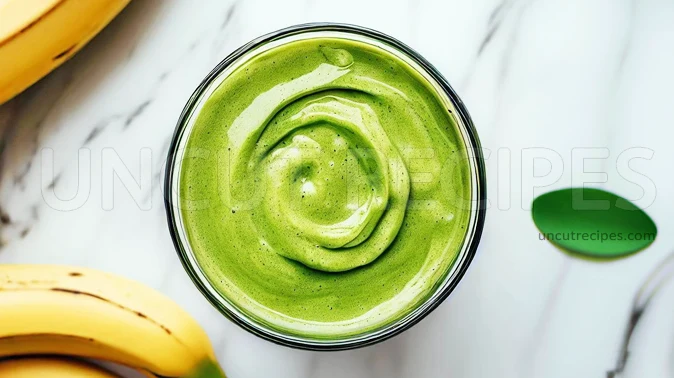
The Japanese matcha smoothie distinguishes itself from Western versions mainly through the quality of the matcha used. Japanese matcha is well-known for its superior quality, the product of delicate shading techniques and meticulous grinding processes. When high-grade matcha is used in a smoothie, it not only adds vibrant color but also complex flavors that can range from umami to sweet, depending on the quality and origin of the matcha.
TIPS:
High-Speed Blender: Use a high-speed blender to get that extra creamy consistency. The rapid blade movement will also help to perfectly incorporate the Matcha powder.
Flash Chilling: To preserve flavors and avoid dilution, use a blast chiller to flash-chill your smoothie before serving.
Pressure Infusion: Use a whipping siphon to infuse additional flavors into the milk, such as vanilla or other spices, for a complex layer of flavors. Charge with a nitrous oxide cartridge and let sit for a few minutes before releasing the pressure and using the milk.
Exact Temperature Control: Control the temperature of your milk to be around 10°C (50°F) to avoid denaturing the proteins, which can affect the smoothie's texture. Use an immersion circulator for precise control.
Micro-Filtration: After blending, consider passing the smoothie through a fine sieve or even a cheesecloth. This will remove any possible lumps, making the texture as smooth as possible.
Ceremonial Grade Matcha: If you're aiming for the best flavor, use ceremonial-grade Matcha. To enhance its aroma, consider pre-whisking it in a "chawan" (Matcha bowl) using a bamboo whisk ("chasen") to aerate it.
Cold Brew Matcha: Instead of adding Matcha directly to the smoothie, cold-brew the Matcha in milk overnight to reduce bitterness and heighten its umami profile.
Method: Mix Matcha and milk and place it in the fridge for at least 8 hours. Strain through a fine mesh to remove any sediment.
Foam Layering: For textural contrast, separate a portion of the milk and use a milk frother to create a frothy layer. Layer this on top of the smoothie.
Method: Take about 20g of milk and froth it until it’s foamy but not stiff. Gently layer this foam on top of the poured smoothie.
Gelato Base: To create a more decadent smoothie, use a gelato base instead of milk for richer texture and flavor.
Method: Prepare a gelato base using milk, sugar, and a stabilizer like guar gum. Freeze it partially before using it in place of milk.
Edible Gold Leaf Garnish: To truly make your Matcha Smoothie a luxurious experience, consider garnishing with a small piece of edible gold leaf.
Method: Using tweezers, carefully place a small piece of edible gold leaf on top of the smoothie after it has been poured into the glass.
Recipe Information
Skill Level
|
Time 3 Minutes |
Price
|
Serves 1 to 8 People |
| Healthiness |
Nutritional Information |
| Ratings (Add Rating & Review) |
Reviews 13 Reviews |
Ingredients:
-
2 cups Milk
2 Medium Bananas
10 Ice Cubes
2 teaspoons Matcha Tea Powder
Allergens
| Dairy |
Directions:
01 - First things first, let's deal with the Banana. Using a sharp knife, carefully slice the Banana into smaller pieces. If you prefer, you can also simply break it into chunks using your hands.
02 - Now, take those Banana pieces and Ice Cubes and place them into your electric blender, mixer, or NutriBullet. This is going to be the base for your smoothie.
03 - Turn on the blender but only for a brief moment—just long enough to start breaking down the Ice Cubes into smaller pieces. You don't want to fully blend it yet; we're just getting things started.
04 - Now it's time to add the Almond Milk. Pour it into the blender with the semi-crushed Ice and Banana. Give it a little blend to mix these ingredients together. Again, you don't need to blend it completely smooth just yet.
05 - Last but not least, let's make this a Matcha Smoothie! Add in the Matcha Tea Powder to the blender. Now, blend everything together until the mixture is smooth and creamy. This is when you want to make sure that all the ingredients are fully incorporated.
06 - Once you're satisfied with the consistency, pour the smoothie into glasses. For that extra flair and flavor, sprinkle a little bit of Matcha Powder on top before serving.
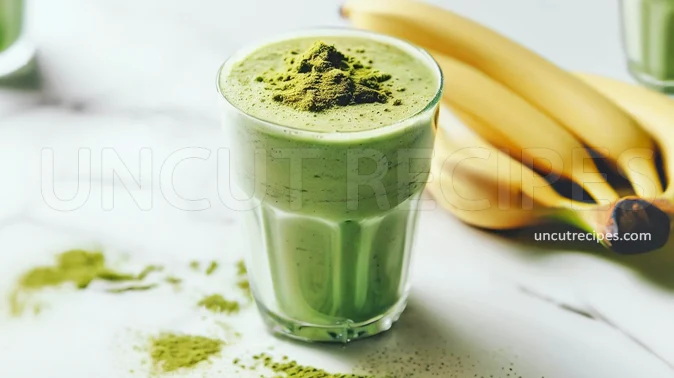
Notes:
Banana Texture and Sweetness: The ripeness of the banana you choose will directly affect the texture and natural sweetness of your smoothie. A more ripe banana will offer a sweeter, creamier texture. You can also freeze your banana slices ahead of time for an even thicker smoothie.
Always opt for an organic banana at its peak ripeness—look for ones that are slightly soft and have a few brown spots. The natural sugars are at their highest at this point, providing natural sweetness.
Matcha Quality Matters: When it comes to matcha, not all brands are created equal. For a high-quality experience, consider using ceremonial-grade matcha from brands like "Ippodo", "Encha" or any organic Matcha. These brands are known for sourcing authentic, high-grade matcha that will give your smoothie a rich, vibrant green color and deep, umami flavor.
Optional Sweeteners: If you find that your smoothie isn't sweet enough, consider adding a touch of organic agave syrup or stevia.
Serving Presentation: For that extra touch, you can garnish the top of the smoothie with a small sprinkle of matcha powder or even a slice of banana. Aesthetically pleasing and adds a burst of flavor right at the first sip.
Short-term Storage: If you can't consume the smoothie immediately, storing it in an airtight container in the fridge is an option, though consuming it fresh is best. Make sure to give it a good shake or stir before drinking, as separation may occur.
Nutritional Information
( Per Portion )
|
Calories |
150 kcal (8%) |
| Total Carbohydrate | 25g (9%) |
| Cholesterol | 10mg (3%) |
|
Total Fat |
3g (4%) |
| Saturated Fat | 1.5g (8%) |
| Polyunsaturated Fat | 0.5g |
| Monounsaturated Fat | 1g |
| Trans Fat | 0g |
| Fibers | 1.5g (6%) |
| Protein | 5g (10%) |
| Sugar | 18g |
| Added Sugar | 0g |
|
Vitamin A |
150 IU (5%) |
|
Vitamin B1 (Thiamin) |
0.1mg (8%) |
| Vitamin B2 (Riboflavin) | 0.2mg (15%) |
| Vitamin B3 (Niacin) | 1mg (5%) |
| Vitamin B5 (Pantothenic Acid) | 0.5mg (10%) |
| Vitamin B6 | 0.2mg (10%) |
| Vitamin B7 (Biotin) | 5mcg (17%) |
| Vitamin B9 (Folate) | 20mcg (5%) |
| Vitamin B12 | 0.9mcg (15%) |
| Vitamin C | 5mg (6%) |
| Vitamin D | 50 IU (25%) |
| Vitamin E | 0.5mg (3%) |
| Vitamin K | 25mcg (21%) |
| Choline | 20mg (4%) |
| Carnitine | 1mg |
|
Calcium |
150mg (15%) |
|
Chloride |
80mg (4%) |
| Chromium | 1mcg (3%) |
| Copper | 0.1mg (5%) |
| Fluoride | 0.1mcg |
| Iodine | 15mcg (10%) |
| Iron | 0.4mg (2%) |
| Magnesium | 30mg (7%) |
| Manganese | 0.2mg (10%) |
| Molybdenum | 2mcg (4%) |
| Phosphorus | 110mg (9%) |
| Potassium | 300mg (6%) |
| Selenium | 2mcg (4%) |
| Sodium | 50mg (2%) |
| Sulfur | 30mg |
| Zink | 0.5mg (5%) |
* Percent Daily Values are based on a 2,000 calorie diet. Your daily values may be higher or lower depending on your calorie needs.
** Nutrient information is available for all ingredients in this recipe. Amount is based on available nutrient data collected from all over the internet.
(-) Information is not currently available for this nutrient. If you are following a medically restrictive diet, please consult your doctor or registered dietitian before preparing this recipe for personal consumption. |
| Written by: Uncut Recipes | Disclaimer |


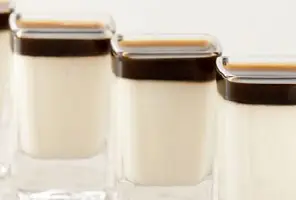

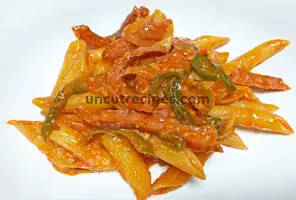
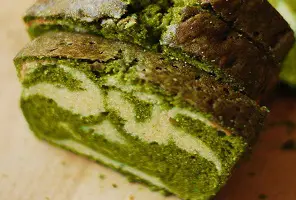
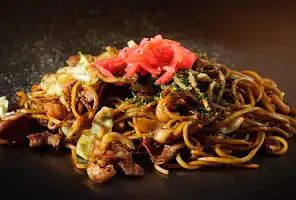



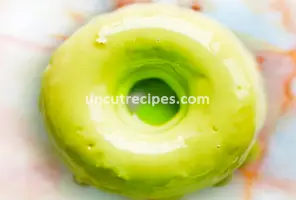

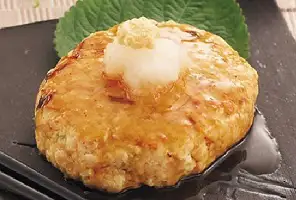

September 05, 2023
This was great! My rating has to be 5 stars! Thank you